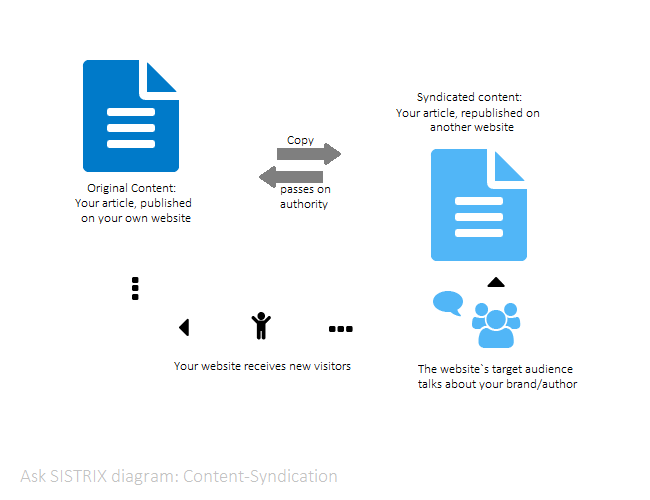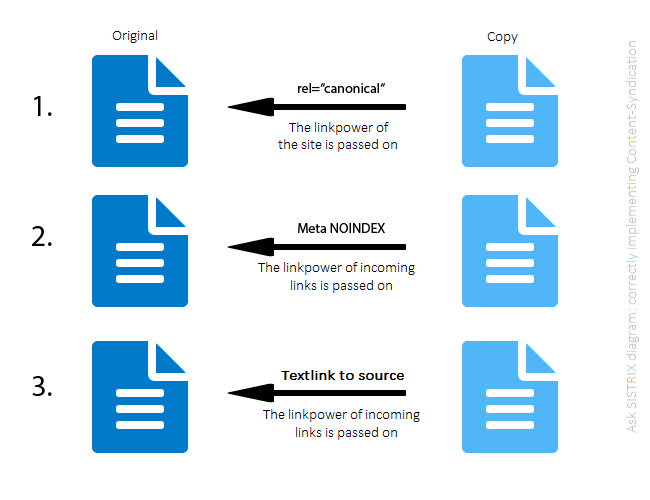Content-Syndication is using specific (media) content multiple times. These can be articles, interviews, blogposts, studies as well as any other kind of text can be (media) content as well as infographics, videos, podcasts, etc.
- Definition of Content-Syndication
- Using Content-Syndication as an SEO strategy
- Risk of Duplicate Content through Content-Syndication
- Properly implementing Content-Syndication - How it's done
- Real-world example of Content-Syndication
- Tips for Content-Syndication
- Video explanation from Matt Cutts / Google on the subject
- Can I use rel=canonical when publishing articles on different sites?
- Additional information on the subject:
Definition of Content-Syndication
Anyone offering Content-Syndication gives their content, of which they are the author, to third parties for them to reutilise. This way, for example, you publish an article on you own blog first and then republish it again a few days or weeks later on another website, with may have a broader audience or a larger coverage. This process is called Content-Syndication.
Using Content-Syndication as an SEO strategy
The opportunity of making your own content accessible to a larger audience using Content-Syndication is, if properly done, a good SEO strategy. Oftentimes you will be able to kill two birds with one stone: You can strengthen the reputation of your own domain or that of the specific author, and it is an effective means of link building.
However, we will focus on using Content-Syndication for your own domain and how to properly implement it.
In the above graphic you will find the explanation of how to use Content-Syndication. Your article published on another website is discussed by that site’s readers. The publishing website passes on some of its own authority to your website and some readers of the syndicated article, whose interest is piqued, will visit your website – You get traffic.
Risk of Duplicate Content through Content-Syndication
Content-Syndication is meant for publishing an article on another website without any changes, which you have already published on your own website. This would, by definition, create external Duplicate Content.
This Duplicate Content risk can be taken care of easily, by properly implementing your Content-Syndication.
- Ask SISTRIX: Do quotes constitute a duplicate content problem?
Properly implementing Content-Syndication – How it’s done
The correct realisation, or rather, the correct approach to Content-Syndication is a prerequisite for the success of this SEO strategy. The following chart shows you 3 different ways of handling your Content-Syndication.
The chart shows the best ways to use Content-Syndication, in decreasing order.
- The website publishing the syndicated article adds the rel=”canonical” link element to the <head> area of their HTML source code, which points to the URL of the original document.
This enables Google to identify the author of the article and prefer the original source in the search result pages. The rel=”canonical” link element solves the duplicate content problem in this case. The link power of all incoming backlinks for the “copy” will be passed on to the original website.
- The website publishing the syndicated article added the meta instruction NOINDEX to the <head> area of their HTML source code. This way, the risk of external Duplicate Content is eliminated as,in this case, Google will not rank the “copy” in their search result pages.
This version will also correctly distribute the incoming link power.
- The website publishing the syndicated article neither refers to the original URL using the rel=”canonical“ link element, nor does it use the meta information NOINDEX. Instead, the “copy” has a Dofollow-textlink at the end of the article to the original document.
The Google-Bot can identify the Content-Syndication by crawling both URLs, the original and the copy. Duplicate Content should not be a problem with this solution either. By adding the corresponding textlink at the end of the article, the link power of the “copy” is also passed on to the original.
Real-world example of Content-Syndication
The article with the headline “Mark It Up” was first published on May 15, 2014 on the company blog of the search engine Bing. The author of the blog is Duane Forrester, Sr. Product Manager Bing.
On June 27, 2014, the already published article was republished on the website Search Engine Journal “SEJ” under the headline “Mark It Up: The Importance of Schema“.
“SEJ” chose to use the rel=”canonical” link element here, as can be seen in the HTML source code:
Also praiseworthy: The author of the article also published it on “SEJ” and is mentioned accordingly:
This solution is a lot more elegant than publishing the syndicated article under “guest author” or “guest entry”.
P.S. Mind the social interactions of the readers of “SEJ” that were left for this article on different social networks. It is likely that the original blog entry did not generate nearly as much coverage. It should not be necessary to mention that we can be pretty sure that this article on “SEJ” received a number of backlinks. The rel=”canonical” link element guarantees that the particular link power is passed on to the originating article.
Tips for Content-Syndication
Content-Syndication can be an effective means in your SEO strategy. You use it primarily to generate coverage. The most important thing is obviously still the creation of high-quality content. Because the higher the quality of a content, the higher the effect of Content-Syndication.
Video explanation from Matt Cutts / Google on the subject
The following video response by Matt Cutts is 4 years old by now. The statement that Google cannot completely process rel=”canonical” yet does not apply anymore.
Can I use rel=canonical when publishing articles on different sites?
Can I use rel=canonical when publishing articles on different sites?
Additional information on the subject:
- Google: Using canonical URLs



